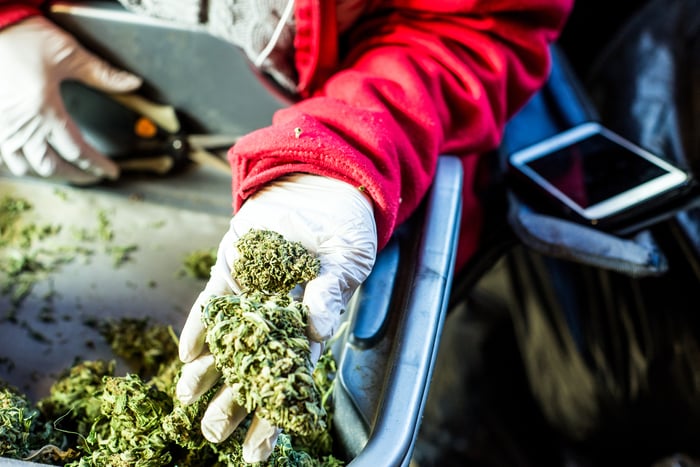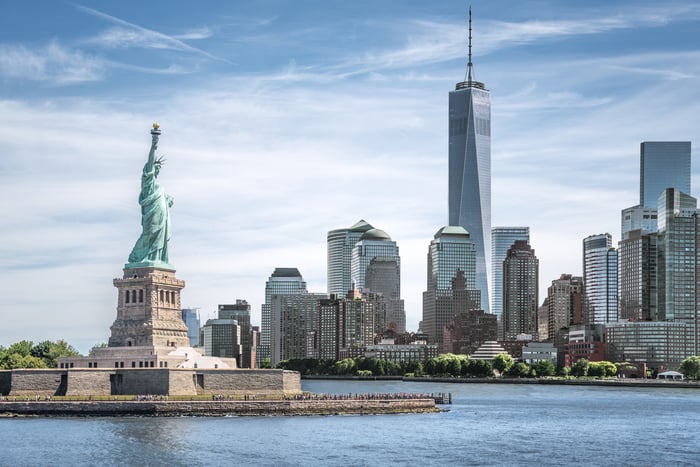Don't blink. Otherwise, you might miss the rapid rate at which the legal cannabis industry is transforming before our eyes.
Back in 1995, there wasn't a state in the U.S. or a country in North America where medical marijuana or recreational marijuana were legal. Fast-forward to today, and things are markedly different.
Mexico legalized medical cannabis a year ago this June, while Canada is on the verge of becoming the first developed country in the world to legalize adult-use weed. (It gave medical weed the OK back in 2001.) Within the U.S., 29 states have passed sweeping medical cannabis laws, with nine also giving the greenlight to adult cannabis use. It's a complete 180 in a span of just two decades.

Image source: Getty Images.
However, as you're probably already aware, the United States presents an interesting case. Unlike Mexico and Canada, which at least recognize cannabis as legal for medical purposes, the U.S. federal government has stood firm on its classification of marijuana as a Schedule I drug. This means it's entirely illegal, is prone to abuse by users, and has no recognized medical benefits.
Yet in spite of this classification, a sort of balancing act has developed between individual states and the federal government. For 22 years, states have been allowed to regulate their own cannabis industries, and the federal government has predominantly kept its distance.
It's certainly not an ideal scenario, given that pot's Schedule I status leads to a host of inherent disadvantages for marijuana-based businesses, but it's what many Americans would call a step in the right direction. After all, 64% of respondents in Gallup's October 2017 survey favored the idea of legalizing marijuana -- the highest percentage in nearly five decades of polling.
So the real question is: Which state is next?
This might be the next state to legalize marijuana
While no one knows that answer with any certainty, the Empire State is certainly making a case to be the 10th state to legalize marijuana for adult consumption.
Earlier this week, New York State's Department of Health (DOH) Commissioner Howard Zucker revealed in a news conference that the DOH plans to recommend that the state legalize and regulate marijuana for recreational use, as well as expand its medical marijuana program to patients currently taking prescription opioids to help combat the opioid crisis. As a note, New York is one of two-dozen states that doesn't have the initiative and referendum process, meaning that all cannabis approvals will need to occur within the state's legislature rather than by a vote of its residents.

Image source: Getty Images.
In particular, the DOH study, which was commissioned by Gov. Andrew Cuomo (D-NY), analyzed the economic, health, and safety impact that legalization has had in New York's neighboring states, and looked at what might happen if legal cannabis were taxed in the Empire State. It also examined what the legal age of use should be, the potential implications of driving while under the influence of pot, and what excise tax rate makes sense. The result was that the positives outweighed the negatives and thus, the upcoming recommendation for legalization.
However, there's a bit of an asterisk that should be placed with this study -- namely, that Zucker's commentary was made with just two days left in New York's legislative session for 2018. Further, the report wasn't even finalized at the time of the conference with reporters. Translation: It's very unlikely that any sort of marijuana reform is going to occur in 2018.
Another factor that could complicate matters is New York's Senate, which is controlled by Republicans. Most surveys show that self-identified Republicans tend to either oppose or have mixed views of legalizing cannabis -- albeit they do favor the idea of expanding access to medical marijuana. In other words, even though the general public, the DOH, and even Gov. Cuomo, appear to be in favor of legalizing pot in New York, the state's Senate could be a brick wall to anything more than an expansion of its medical marijuana program.
Don't expect progress at the federal level
While it's certainly possible we could see a number of new states legalizing pot in some capacity this November, it appears unlikely that the federal government will change its tune anytime soon. In fact, I recently covered seven reasons why the federal government is unlikely to legalize pot.

Image source: GW Pharmaceuticals.
Arguably, one of the biggest hurdles to overcome has been mixed clinical data. On one side of the aisle, marijuana or its cannabinoids have offered what looks to be clear evidence of medical benefits. GW Pharmaceuticals' (GWPH) Epidiolex, a drug designed to treat two rare types of childhood-onset epilepsy, handily met the definition of statistical significance in terms of reducing seizure frequency relative to baseline and the placebo in multiple late-stage trials. GW Pharmaceuticals' lead drug is particularly good news for Dravet syndrome patients -- one of the two indications -- given that there's no Food and Drug Administration-approved therapy to treat that disease.
On the other hand, multiple clinical studies have been undertaken that've shown cannabis use by teens could harm their developing brains and/or impact their long-term memory. It's this bifurcation of data that has lawmakers on Capitol Hill standing pat despite overwhelming support for legalization from the public.
We should also recognize that the GOP is firmly in control of the legislative branch of the federal government, and as noted, they don't particularly care for cannabis. Though it's possible we could see reform on the medical side of the equation, any chance of recreational marijuana reform is probably off the table until Democrats are in control.
Thus, while legal weed sales growth is liable to continue in the U.S., so will the bifurcation of opinions between individual states and the federal government.




